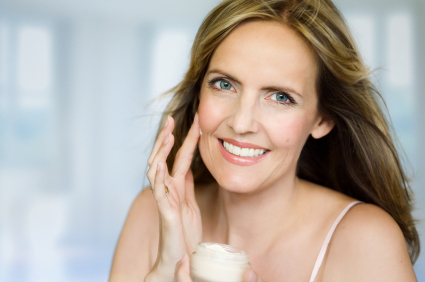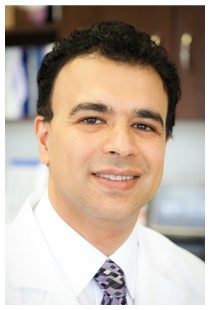Ask the Dermatology Experts About Skin, Hair and Nail Diseases:
Question: Is Argirline (commonly referred to as Botox Cream) effective to treat wrinkles?
Argireline is actually a patented peptide complex that is currently used as an ingredient by numerous beauty product manufacturers and claims to mimic the muscle relaxing properties of Botox with topical application. Argireline’s scientific name is Acetyl Hexapeptide-3 and is manufactured by Lipotec, a Barcelona-based cosmetics research lab.
So what’s so great about Argireline?
The peptide is derived from natural proteins and claims to actually relax facial muscles similar to Botox injections. The theory guiding both products is that relaxed facial muscles will minimize current wrinkles caused by repetitive muscle contractions, as well as prevent new wrinkles. Muscle contractions are guided by a chemical reaction called the “SNAP receptor complex,” and Argireline is specifically designed to interfere with this reaction.
With so many anti-wrinkle creams produced by multiple manufacturers all using Argireline, what’s the difference? For starters, different Argireline-based products use different concentrated solutions of the product. Despite what users might think, a higher concentration solution of Argireline may not be best. Lipotec’s own product trials show that a solution concentrated at 5%-10% has been most effective to date. Before buying an Argireline-based product, try to determine what concentration of the peptide is included. Although raw Argireline is available straight from Lipotec, it is only intended for industrial use and users should not try to formulate their own products at home.
Argireline can currently be found in creams, serums and eye creams. One caution about this peptide is that, like with many cutting edge technologies, long terms effects of consistent Argireline exposure have yet to be observed.
Argireline is a promising option to treat wrinkles in future. However, lack of double blind studies to compare Botox with Argireline questions its real efficacy. Additionally, the use of Argireline by third party product manufacturers is completely unregulated, it is difficult to know the exact concentration of Argireline in some creams, and we do not know how the peptide will react with other included ingredients. There’s definitely a lot of “miracle” potential in Argireline, but be certain to thoroughly research any product that features it before purchasing.
Can Fraxel be used on dark or Hispanic skin types?
Pigmentation is seen as a result of inflammation secondary to micro effect of a laser. Use of hydroquinone 6 weeks before applying the laser can help. However, choice of laser and the setting that your laser specialist will use is very important. Dr, Ghohestani and his team has developed iBright, which is claimed to be the most effective treatment for Melasma and hyper pigmentation. There are three different types of Fraxel: Fraxel refine: A fractional, non-ablative (less invasive than ablative) gentle laser that is used for skin rejuvenation and resurfacing Fraxel restore: A Fraxel system for non-ablative skin resurfacing and rejuvenation, Fraxel repair: A fractional CO2 laser providing ablative efficacy with fast recovery. Fraxel refine is less invasive and can be a reasonable choice for a dark or a Hispanic skin types. Fraxel refine uses a more superficially absorbed wavelength that is optimized for superficial treatments at lower energy levels, while still enabling treatment up to 650 µm deep into the dermis. It provides an effective skin rejuvenation treatment that improves texture, tone, pigmentation and periorbital fine lines – all with less downtime and less discomfort. Remember, everything is relative! Since the 1410 nm fiber laser targets water, not melanin, Fraxel refine treatment seems to be relatively safe on dark and Hispanic skin types compare to other Fraxels. Testing on one small area, in any doubtful situation, is highly suggested.
What are the danger signs of skin cancer?
We encourage the use of the “ABCDE rule” to detect malignant melanoma.
A (ASYMMETRY): when one part of a mole or birthmark does not match the other side.
B (BORDER): The edges are irregular, ragged, notched or blurred.
C (COLOR): The color is not the same all over and may include shades of brown or black, sometimes with patches of red, white or blue.
D (DIAMETER): The spot is larger than 6 millimeters across (about ¼ inch – the size of a pencil eraser) or is growing larger.
E (Evolution): There is a rapid growth of a mole.
Are there any new treatments for Hyperhidrosis?
Accent Radio frequency is a new effective treatment for hyperhidrosis. There is also a topical product (Hydrosal, Valeo Pharma) that contains 15% aluminium chloride in a 2% salicylic acid gel base. A recent open-label study on 30 patients with primary axillary hyperhidrosis showed a significant improvement in patients’ symptoms. Previous products that contained aquous alchohol seemed to be too irritating for patients. Botox is another option, and it is considered an effective treatment for hyperhidrosis. Botox lasts for about 6 months.
Are the Sun’s rays more intense in Texas?
In some areas of the country, environmental factors have damaged the Earth’s ozone layer, making the sun’s rays more intense in those regions. To find out what the UV index is in your area, you can visit the U.S. Environmental Protection Agency’s SunWise Program Web site at www.epa.gov/sunwise/uvindex.html.
Does TXID see patients with hair and nail disorders?
Yes, the Texas Institute of Dermatology, Laser and Cosmetics offers excellence in all areas of dermatological care including skin cancer, acne, autoimmune skin disorders, hair and nail disorders, and cosmetic dermatology.
How does Botox work?
Botox is made from a toxin produced by the bacterium Clostridium botulinum. Doctors use it in small doses to treat health problems including:
- temporary removal of facial wrinkles
- severe underarm sweating
- Cervical dystonia – a neurological disorder that causes severe neck and shoulder muscle contractions
- Blepharospasm – uncontrollable blinking
- Strabismus – misaligned eyes
Botox injections work by weakening or paralyzing certain muscles or by blocking certain nerves. The effects last about 3-6 months. Side effects can include pain at the injection site, flu-like symptoms, headache and upset stomach. Injections in the face may also cause temporary drooping eyelids. You should not use Botox if you are pregnant or breast feeding. Patients with any neurological disease should consult their physcian before injection.
What is Juvederm Voluma?
Juvéderm Voluma ® is a smooth consistency gel made of hyaluronic acid (HA)—a naturally occurring substance in your skin that helps to add volume and hydration. Your healthcare professional eases Juvéderm Voluma ® injectable gel under the skin to instantly restore your skin’s volume and smooth away facial wrinkles and folds, like your “smile lines” or “parentheses” (nasolabial folds—the creases that run from the bottom of your nose to the corners of your mouth). There are several forms of Juvederm: Juvederm Ultra Plus that contains more cross linked HA so it will last longer. Juvederm XC Ultra and Juvderm XC Ultra Plus are similar to Juvederm Ultra and Juvederm Ultra Plus, respectively in terms of HA. The XC products also contain a numbing medication called lidocaine that will cause the injection significantly less painful. Voluma is a relatively new FDA approved filler that may last about 2 years.
What is LATISSE?
LATISSE™ (bimatoprost ophthalmic solution) 0.03% is approved by the FDA for inadequate or not having enough eyelashes, growing them longer, fuller and darker. LATISSE™ makes lash growth possible because of its active ingredient: bimatoprost. Although the precise mechanism of action is not known, research suggests that the growth of eyelashes occurs by increasing the percent of hairs in, and the duration of, the anagen (or growth) phase. Lashes can grow longer, thicker and darker because bimatoprost can also prolong this growth phase. Patients with glaucoma or other eye diseases should consult an ophthalmologist before using LATISSE.
Is there any link between diet and acne?
For years, the common belief was diet had absolutely no effect on acne. Turns out, it may have been wrong. A study completed by Australia’s RMIT University and Royal Melbourne Hospital Department of Dermatology have discovered what is being hailed as a “solid link” between diet and acne development. Associate Professor Neil Mann, from RMIT University’s School of Applied Sciences, led the research team which spent more than two years studying metabolic changes in glucose and insulin levels due to diet and the resulting changes on the skin. Researchers believe carbohydrates with a high glycemic index, which cause glucose and insulin levels to spike, may influence the development and severity of acne. Conversely, a diet high in protein and carbohydrates with a low glycemic index seemed to improve acne breakouts. So, is diet alone going to clear your acne? Probably not. However, a healthy diet will certainly improve your overall health. Instead of highly processed foods, try incorporating more whole grains (such as whole wheat bread, wheat pastas, brown rice, oatmeal, etc.) into your diet, as well as plenty of fresh vegetables, fruit, and lean protein. Limit the amount of soda, sugary snacks, and other “junk foods” whenever possible. You have nothing to lose, and a healthy body to gain, even possibly clearer skin, too.
Does nutrition make a difference in skin rejuvenation?
It would be naive to believe that changing your nutrition is going to wipe out all your wrinkles or completely stop skin aging. But it is just as naive to think that you can eat (or neglect to eat) whatever you want without any effect on your skin. What you eat affects every organ in your body, and skin is no exception. You may think that as long as you are using an expensive skin cream with a bunch of ingredients with scientific-sounding names, your skin will be properly nourished. Nothing can be further from the truth. While a skin cream may provide a number of important substances, it is never enough to ensure a proper, all-round skin nutrition.
I don’t eat healthy, but I apply several vitamin creams onto my skin. What is your advice?
Every cell in the human body needs dozens and dozens of nutrients and metabolites. Some, like vitamins, minerals and essential amino acids need to come from food. Others are produced by the body, provided it is healthy and properly nourished. No skin cream can replace that. Applying a cream with nutrients to the surface of you skin does not ensure that those nutrients actually penetrate into your skin cells. They may just “sit there” until your next shower. How much of the active ingredients actually get into your skin cells depends on the skin’s condition, concentration of the ingredients, manufacturing technology and many other factors. This doesn’t mean that all topical preparations are useless — but they are often unreliable. On the other hand, when the nutrients are ingested and absorbed into your bloodstream, they are sure to be delivered to your skin cells.
******
Why should you choose the Texas Institute of Dermatology for your Skin, Hair and Nail Diseases?
At the Texas Institute of Dermatology, we want you to have an excellent outcome and to feel that your needs and concerns have been promptly addressed in a caring and sensitive fashion. We strive diligently to ensure your satisfaction, comfort, privacy, and safety. All treatments are supervised or performed by Dr. Ghohestani with many years of successful experience in a large variety of procedures. Many treatment modalities are available, and we can recommend the one or two that are most likely to meet your needs; we’re here to meet your needs and help you realize your aspirations. At our clinic in San Antonio, Texas, we serve communities throughout Bexar County and Kendall County, including San Antonio, Boerne, Leon Spring, Ralph Fair Ranch, Canyon Lake city; many of our patients also come from Laredo, San Marcos, New Braunfels, Kerrville, Austin, Wimberley and Corpus Christi.







